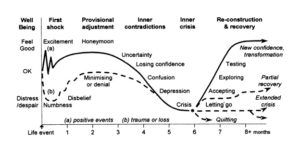Every year about 25% of managers change jobs. Some get promoted, some laterally, and some transitioning into new companies. Virtually no one plans an onboarding strategy and as such, 75% of transitions fail to reap expected gains. “John looked so promising” but he’s “underperforming” or “not fitting in” are common complaints. In addition to the 25% of managers changing jobs yearly, it’s not unrealistic to say that company’s have a 10% staffing churn yearly.
You want to leave a positive impact during your era in the company or role, not a failed on-boarding.
Have you ever studied the process of integrating yourself into a new company, or new role within your company? The vast majority would answer “no”. Compared to business books on other practices, there are surprisingly limited resources on onboarding. The result is a onboarding roller coaster ride called Hopson transition curve.
Most companies struggle with onboarding new staff or transitioning existing staff. Most will understand very little about the transition curve. Most companies are “reactive” in nature to onboarding or transition problems.
Why Study Onboarding?
Everyone can remember criticizing the new idiots at the helm (if you’re one of my ex-managers reading this, I wasn’t referring to you – you were the exception). We criticized their decisions, their tactics, their people skills, their approaches to problems. If you don’t study how to onboard successfully, you become one of those idiots, or worse, your employment is terminated.
On-boarding Management as a Differentiator
There are plenty of solid business books and university/college courses on Business Management, but surprisingly, very few on on-boarding.
Many organizations provide new hires with a short-term orientation session, in hopes to acclimatize you to their (your new) company. One company that does excel in management training is GE. The excellent book Good to Great notes that many GE trained managers have gone on to become heads of major companies. Planning and training for onboarding does work.
Like most, you learned onboarding the hard way, the sink or swim model. You learned from your successes and hopefully equally from mistakes. Much of the onboarding process we know and execute at a subconscious level, is never put into a transition plan, a transition framework. After studying the topic, my recommendation is to develop your own onboarding plan.
This is the first in a series of blog posts on the topic of Onboarding. My objective is to eliminate the valley in the transition curve.
On-boarding Definition
- Promotion, lateral move
- Acquiring staff for the first time
- Joining a new company
- Any functional change in your responsibilities
- Same role, same company, new geographical location
Prior to Your Start-Day
Learning begins prior to joining the new firm or staring the new role. Your personal learning meter should be running from the moment you learn you’ve landed the job.
There’s a number of learning tools at your disposal to aid in ramping-up before you join:
- Ask your new employer for any additional relevant documentation, for example: recent staff and/or client surveys or focus group results, meeting minutes, product focus groups, whitepapers, manuals
- Learn about the organization’s people, structure, performance (annual reports) and clients
- Google the firm, their products, their people, product reviews, etc.
- Search product reviews, blogs, and relevant Twitter accounts (i.e. follow their people, clients, suppliers, if not already doing so), Youtube, etc.
- Speak with suppliers and customers. You may circle back to these same people later on in your learning plan
- Speak with former employees (ideally from within your network)
- Speak with your predecessor or ex-staff if possible. Linkedin will find them
- Learn the company’s strategy
- Meetup with your new manager for a structured meeting
- Try the product if possible and applicable
- Use the above to being compiling your unique initial questions to start the journey once “on the inside”.
This is the first in a series of Job Transition blogs, written to help you during your on-boarding journey.


